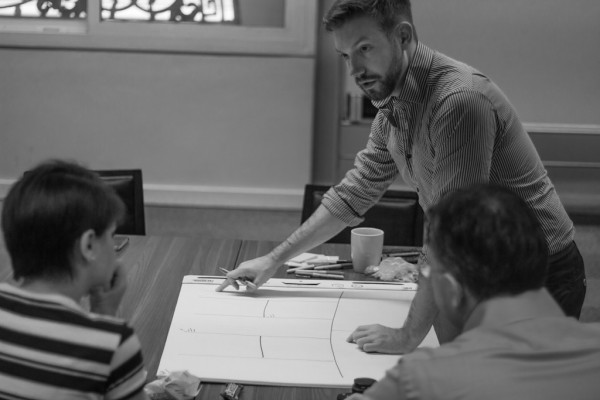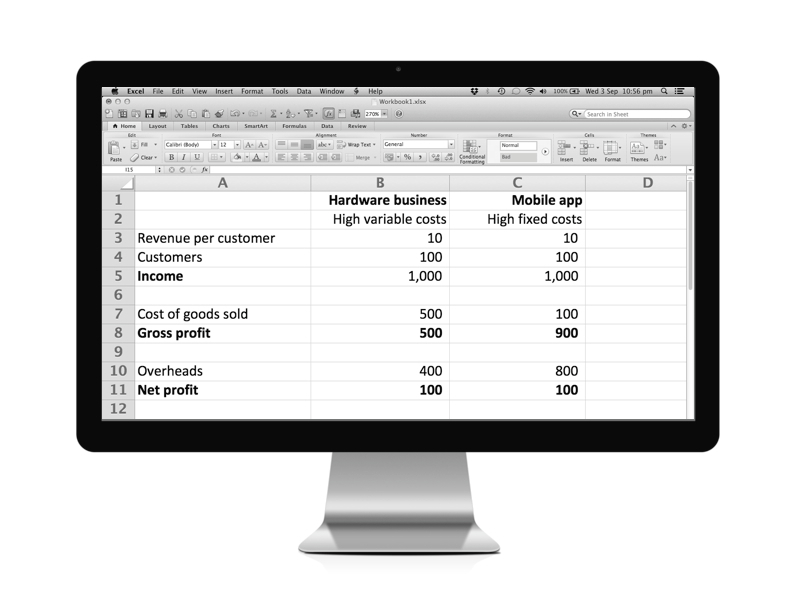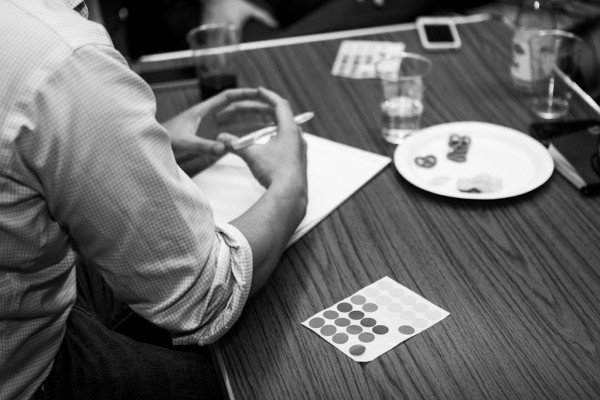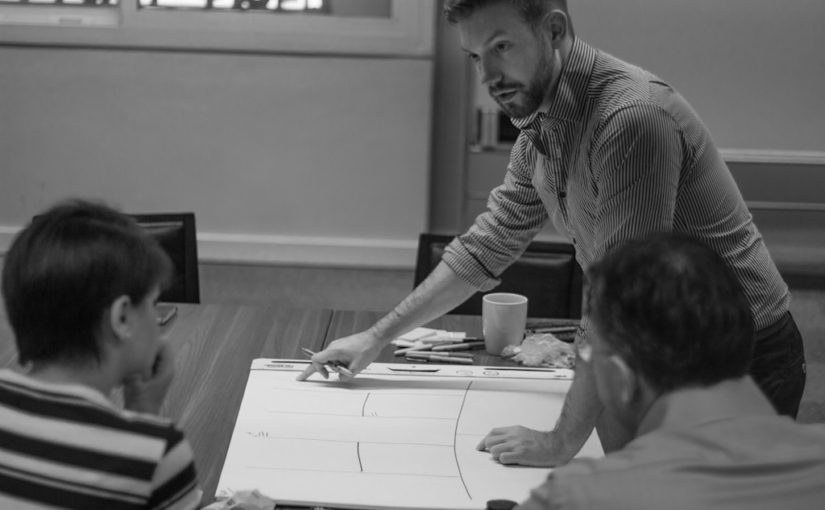Business design is a new way of thinking about companies as interconnected systems worthy of innovation, creativity and the application of design to the systems themselves. Business design applies the mindsets of a designer to the task of creating the overall strategy and business model.

Business design is a useful way of looking creatively at a company in the context of its customers, suppliers and competitors. Every company needs to combine the disciplines of technology, design and business together to deliver value for a customer. But too often, only the crafts of technology and design are seen as real sources of new innovation (with the business function itself just doing the marketing or arranging the finances). In reality, the business-side of innovation can be incredibly important.
A business designer looks at the ways that flows of cash through a business to help diagnose important areas for the application of design. Money isn’t always the primary goal of a great business, but it’s a pretty good way of keeping score. As an economist, I was trained to view money as simply a byproduct of two-parties who are voluntarily exchanging value. This is a great mindset for strategy because it focuses on creating customer value first. Cash is the lifeblood of a growing organisation so designing a strong business model and engine of growth are an important part of entrepreneurship.
By using the mindset of business design, you can see metrics and KPIs as levers for innovation rather than just things to measure after the fact. For example, knowing the lifetime-value of a customer and the cost of acquisition might suggest that more innovation is needed to decrease customer churn. For example, cellphone providers are obsessed with decreasing churn and will often offer amazing discounts if you threaten to move to another provider. This is because they know that the cost of keeping a customer is cheaper than the cost of acquiring a new one.

What is business design?
This new discipline is emerging gradually as business people such as accountants, consultants and investors realise that their craft needs to keep up with startups who are innovating faster than ever before. The old school command and control model of business planning doesn’t work when a competitor could pivot into an entirely new customer segment and undercut your entire business model. These days, life has already moved on before a traditional strategy report can even be printed.
The new agile model of business strategy is called “business design” because the aim is to design the entire business as if it was an interconnected system. And then to maintain or adapt that system as circumstances change. Business design draws heavily on the mindset of human-centred design thinking and applies that mindset to the task of creating the entire financial and operating model.
Business design can be used early on in a startup (to achitect the entire business) or it can be used in large companies to make real-world decisions at the level of business units and product management. The mark of a good business designer is that they are equally at home using a spreadsheet as a design tool.
“If a strategist hasn’t asked to see your financial statements, then they’re not really a business designer.”
Business design is a living process rather than a one-time event. Business design is like bailing the boat while still paddling, or adjusting the course of a GPS navigation system on the fly. The destination is not as important as the ongoing process of continual course-correction.
For example, a recent client of mine had two seemingly similar service offers priced at wildy different price points, one was a short-term contract for a higher price and the other was a long-term contract for a much lower price. At first blush, the low price offer seemed less profitable because the internal cost-base for both services was the same. We had to undertake a business model review (including the financial accounts) to identify just how important the long-term contracts were to predictable cashflow. The two services therefore needed to be positioned more effectively so that they didn’t cannibalise each other.
Business design requires a peculiar combination of a high tolerance for ambiguity and a love of systems, analytics and metrics. A business designer trades in both the imagination of the future and the nitty-gritty modelling and planning that makes the vision into a reality.

Who buys a business designer’s services?
Business design skills are becoming a key part of the service offering that clients expect from innovative digital agencies and product design firms. The purchasing of design services is shifting from the marketing team to innovation and product managers. Therefore, clients are giving more open briefs and are expecting to see sound business justification for proposed investments.
The marketing team’s role is also shifting from making people want things, to making things that people want. Therefore, design firms are being forced to embrace more and more ambiguity in the brief. Many marketing teams are now saying to their agencies:
“I don’t care if it’s a micro-site, a mobile app, a short video or a pop-up stunt. I just want to do something that makes our customers love us. What can you do to help me?”
A business designer can help answer that question because they are uniquely trained to tolerate ambiguity. Moreover, a business designer can help by drilling into what the client really wants to achieve and what the new product, service or campaign would need to deliver to make a real difference.
“A business designer is responsible for doing whatever it takes to see the idea come to life and create value for the end user.”
Unlike advertising planners, business designers often stay involved in the project right through to completion. The traditional planning model assumed that every variable could be accounted for in advance. Whereas, in modern business strategy, things change so fast that the business designer needs to stay involved in the iterative lean cycles of build, measure & learn.
Business design is inherently digital
Social media and digital communication has disrupted many industries at the very core of their business models and value propositions. The practical tools of business design are an important part of the new trends for social business, lean startup and digital transformation.
People can smell inauthenticity very quickly on social media so companies need to be social to the core. Digital strategy is often an important part of business design because the best online community building activities are always deeply rooted in the company’s vision, purpose and values. Business design is inherently digital because a good business designer starts with an unflinching examination of real customer behaviour (which these days is usually online).
How does a business designer fit into the lean startup process?
In the lean startup model, innovation is viewed as a series of iterative cycles (build, measure, learn). A business designer can add the most value during the measure and learn phases but there is also a role to play in the marketing and finance side of the build phase.
Hackathons are a great way to experiment with innovation but the role of business people in a weekend sprint process isn’t immediately obvious. In practice, I’ve found that I’m always busy during a hackathon. Early in the weekend, I’m running to make the ideation and creative process as inclusive as possible. During the middle of the weekend, I’m busy interviewing potential customers, trying to invent a revenue model or hack together a promotional campaign. By the end of the weekend, I’m creating the slide deck and rehearsing the final presentation with the team.
How does a business designer fit into an agency workflow?
The role of business designer as glue in the process during a hackathon translates back into the cross-functional way a business designer works on normal day-to-day project. The three main things that a business designer focuses on:
- Help clients articulate new a value proposition across their organisation and gain support for their initiatives.
- Help clients shape a business case and design brief where they are unsure about what a new product should do.
- Help clients see the value of design thinking, particularly how design can help to meet real people’s needs, think ‘customer first’ and get to the truth of a situation.
Who are the best people to learn business design from?
Business design is a toolkit used inside product design, brand design, PR and innovation agencies. Usually, the business design tasks fall to strategists and planners. But a growing group of professionals are taking a more business-led focus in their strategy work and specifically calling themselves “business designers”.
The best practitioners in the field of business design today include John Oswald from Fjord, Jon Snow from LBI, Diego Rodriguez & Tom Hulme from Ideo and Gabbi Cahane from Meanwhile. At a more corporate level, David Edelman from McKinsey is also doing good work on digital innovation and business design.
The best thinkers in the field of business design include Eric Ries, Alex Osterwalder and Guy Kawasaki. The old school business thinkers like Tom Peters, Peter Drucker and Clayton Christianson are still relevant because the fundamentals of business strategy haven’t changed. They just need to be implemented faster.
If you want to incorporate the tools of business design into your startup, project or agency then my version of the Value Proposition Canvas is a good place to start. The most important mantra you need to remember as a business designer to simply ask “Where is the money?”

Great article and to the point !! As a branding guy I can totally agree with this article.